JORGE OSCAR DE SANT´ANNA PIZARRO, Petrobras, Phd; CELSO CESAR MOREIRA BRANCO, Petrobras, Msc
Carbonate reservoirs contain a significant portion of the world’s oil reserves. However, exploitation presents several challenges, primarily associated with their complex pore geometry, large-scale permeability variation and, sometimes, unfavorable wettability. These challenges can become more significant in a deep offshore environment. Since offshore projects need to be planned well in advance, due to the lack of room on platforms for future expansion, initial application of EOR methods needs to be considered from the development’s conceptual stage.
The Lula field encompasses the Tupi and Iracema areas, This article addresses the approach used to plan the development of the Tupi area of the Lula field in the Santos basin Pre-Salt Cluster (SBPSC), offshore Brazil. It focuses on the strategy of phased development, dynamic data acquisition, and actions to add flexibility to the production system and how to manage uncertainties. A comprehensive analysis of the existing uncertainties—such as reservoir characterization, early water and gas breakthrough, bypassed oil saturation, flow assurance in deepwater flowlines and CaCO3 scale possibility in production wells—favored a phased development concept aimed to mitigate risks. The approach used to cope with these uncertainties in a pilot project, as well as in future development scenarios, is presented. Most of the discussion focuses on considerations for possible enhanced oil recovery (EOR) techniques through pilot testing, and their future, large-scale field implementation. Different recovery processes and initial field results are discussed, including miscible processes using hydrocarbon (HC) gas and CO2. To optimize oil displacement, a water-alternating-gas (WAG) injection process is also being designed.
After a year and a half of extended well test production and implementation of the first pilot project, beginning in January 2011, results confirm the decision to provide additional project flexibility. Dynamic appraisal proved essential to assess reservoir connectivity, evaluate stimulation methods, support reservoir characterization studies and define aspects related to flow in subsea lines. Initial results of CO2 (separated from associated gas in the pilot) injection indicate that the chosen strategy has the potential to be successful. The Lula Pilot is currently (July 2012) producing 97 kstb through four producers and one gas injector well. Water injection is planned to start this September. Continued production and pressure data monitoring of the pilot WAG, will provide more definitive results about project feasibility. EOR will be expanded to field scale, if responses are good.
INTRODUCTION
Exploitation strategies for petroleum reservoirs in deep offshore fields present significant differences compared to onshore locations. Bondor, et al., 20051, discussed the benefits and challenges associated with planning EOR projects in offshore fields. The authors emphasize that since the size of developed offshore fields is usually significantly larger than for fields onshore, the remaining resources after conventional recovery are considerable. However, offshore constraints and high capital expenditures imply additional technical and economic risks. These factors may explain why the authors found only nine offshore EOR projects implemented around the world.
The complexity of implementing an offshore EOR project increases significantly with the move to ultra-deep waters. Since investments are normally huge, more appraisal and data acquisition is needed to reduce uncertainties and mitigate associated risks before sanctioning the project. However, due to high costs, information acquisition usually is balanced with accepting a higher degree of risk or adding flexibility to the project. This context makes it challenging to consider EOR application in this kind of project.
Usually, EOR methods require additional installation capabilities that can be impeditive to consider in an offshore facility, if they are not planned very well in advance. Additionally, during early stages of development, each reservoir property description presents several uncertainties. This is particularly true for the petrophysical properties distribution, and even more critical in carbonate reservoirs, which usually present a higher degree of heterogeneity than sandstones.
The following article describes the specifics of the Tupi area environment, the conceptual approach being used in its development, and how it is related to the EOR implementation strategies being considered.
SANTOS BASIN PRE -SALT ENVIRONMENT
Petrobras discovered Lula field in 2006, considered to be Brazil’s first super-giant field. The area known as the Santos basin Pre-Salt Cluster (SBPSC) is in ultra-deep waters, between 1,800 and 2,400 m (5,906 and 7,874 ft), about 300 km (186 ft) offshore the Rio de Janeiro coast, southeastern Brazil. Figure 1 shows Lula field and other SBPSC blocks in which Petrobras participates. They are in the appraisal and early development phase.
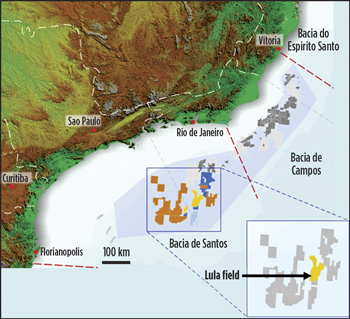 |
| Fig. 1. Lula field and pre-salt cluster areas in the Santos basin, Brazil. |
|
Formigli, et al., 20092, described this province’s main characteristics. The geological structures were formed around 160 million years ago, when the super-continent, Gondwana, began to break apart, giving birth to the South American and African continents. The rift phase created conditions for the deposition of sediments in the trough between the two continents. As the separation continued, sea water began to fill the space, creating a low-energy, high-salinity environment, propitious to the growth of special bacterial colonies. The secretion of these microorganisms, together with the precipitation of carbonate salts, created the nucleus to form carbonate rocks, known as microbialites. Later, due to severe climate change on Earth, the salt dissolved in the sea water, in this low-energy environment, precipitated, forming a thick salt layer that became a perfect seal for the hydrocarbons that migrated to the microbialite reservoirs. Figure 2 illustrates the environment where Lula and other presalt fields are located.
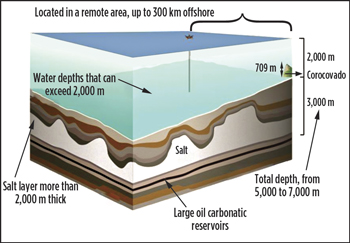 |
| Fig. 2. Santos basin pre-salt environment. |
|
Lula field was discovered by the 1-RJS-628A wildcat, which, when tested, flowed 28°API oil, with a GOR of 240 m3/m3. The reservoir occurs just below a thick salt column of about 2,000 m. In July 2007, appraisal well 3-RJS-646 (Tupi Sul lead), located 10 km south of the discovery well, was drilled. It confirmed previous results,2 but with even better reservoir characteristics than those found in 1-RJS-628. An appraisal plan was implemented, including the drilling of additional wells, several DSTs and a high-resolution seismic shoot. In general, Tupi area has light oil (28° to 30°API) and a high solution gas ratio (200 to 300 m3/m3). As with other carbonate reservoirs, the solution gas contains some CO2, varying mostly from 8% to 15%. Operator Petrobras holds 65% of work interest in the block. BG E&P Brasil Ltd. Holds 25%, and Petrogal Brasil holds 10%. Figure 3 shows a map of the Tupi area of the Lula field with the several wells already drilled.
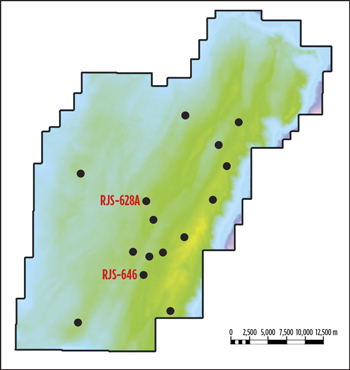 |
| Fig. 3. Wells drilled in the Tupi area of Lula field. |
|
The development strategy employs production systems with the flexibility to operate in different scenarios, which will be revealed during development. Much of the reasoning behind this flexibility is associated with implementing EOR in the fields. To anticipate dynamic information that will allow optimizing the design of the production systems and oil recovery strategies, Petrobras and partners decided to start extended well tests (EWTs) and pilot systems. In May 2009, the FPSO BW Cidade de São Vicente was installed in the Tupi area, moored in 2,160 m of water, about 280 km off the coast. About 15,000 bopd were produced on average, through a single well that operated constrained. By the end of 2010, the BM-S-11 consortium declared Lula commercial to the Brazilian National Agency for Oil, Gas and Biofuels (ANP).3
PHASE D DEVELOPMENT CONCEPT
Development of each area in the pre-salt cluster follows the successful strategy applied by Petrobras during development of most of its deepwater fields—a phased development. This concept consists of:
-
Extended well tests (EWTs), to evaluate the wells’ longterm production behavior
-
Production pilots, to test recovery method performance
-
Definitive systems, for large-scale production, incorporating the knowledge acquired through the previous two steps.
Phased development aims to progressively reduce the risks of optimizing the production systems, and also to balance ex-penditures with revenues. Naturally, as knowledge and confidence in the production behavior increases, less value will be given to the EWTs and pilots, and they could be reduced progressively. It is noteworthy that the early operation of pilot projects also provides valuable information for future EOR by WAG injection optimization, as will be discussed later in this article.
Following this strategy, Lula field development was sub-divided in three phases, as described below.
Phase 0, Information acquisition. This included appraisal well drilling; reservoir coring; description and complete logging; fluid sampling and laboratory tests; high-resolution seismic acquisition and interpretation; cased hole well tests; evaluation of different well geometries; testing of different well stimulation techniques; analysis of flow assurance issues, etc. In this stage, early production development projects were designed and implemented (Nakano, et al., 20094), such as:
-
Tupi EWT was begun in May 2009 with a single well (RJS- 646) connected through a subsea flowline to an FPSO moored in 2,160 m of water. Although the well potential was about 3,650 m3/d, it produced constrained during the EWT, with an average oil rate of 2,385 m3/d. The rate was limited by the maximum gas flaring rate permitted by Brazilian authorities.
-
A second EWT took place in the northeastern area of the field from April to November 2011. Results were similar to those obtained in the first EWT, but they showed complmentary reservoir features.
-
Lula Pilot comprised a chartered FPSO designed to produce 15,900 m3/d (100,000 bopd). Output began Oct. 28, 2010, with the P1 well (until the end of 2010, this was also considered an EWT). In April 2011, gas injection started with well IG-1.
Phase 1A, definitive development using mostly conventional solutions: This phase will last from 2012 to 2017, and will comprise the deployment of several production units, including one additionalchartered FPSO for the Lula Nordeste Pilot. First oil is forecasted for 2013, and the Lula Pilot will be expanded to evaluate the performance of waterflooding, gas flooding and Water-Alternating- Gas (WAG). In the WAG process, the gas can be a hydrocarbon from the producing reservoir, or CO2 originally contained in the associated gas, stripped in the FPSO processing plant. This phase also will include deployment of standardized FPSOs, in different parts of the fields (planned to occur from 2015 to 2017). Different well geometries will also be tested.
Phase 1B, definitive development with non-conventional solutions in large scale. In this phase, the intention is to deploy non-conventional solutions on a larger scale to complete development of the pre-salt cluster, while reducing production costs and optimizing recovery. Fit-for-purpose production units probably will be employed, as well as subsea processing and pumping and a broader application of EOR processes, based on WAG with HC gas and WAG with CO2.
Two technical aspects of the above strategy are worth additional comment.
Importance given to Dynamic Appraisal: The evaluation of flow in the reservoir can be made with DSTs—usually very shortterm production (less than 72 hr)—and EWTs, which for the operation of a single producer, last about six months, tracking flowrates, and downhole and wellhead pressures and temperatures.5
EWTs are an excellent source of information on the dynamic performance of a well and surrounding reservoir. Aspects of productivity behavior, damage evolution and flow assurance can be studied more thoroughly than in a simple DST. Reservoir fluid property variations, such as compositional gradients, may also be evaluated during EWT production, by monitoring the produced oil and gas composition. And, when coupled with the appraisal of a nearby well, it is possible to evaluate through pressure interference the lateral and vertical connectivity along the reservoir. The method, referred by Dake, 19946, as “dynamic appraisal,” can provide valuable information to support the drainage plan and sweep strategy in the pre-salt. It is a Petrobras tradition to develop its giant fields in deep water, reducing the risks associated to the definitive systems.
Built-in flexibility of floating production units: These units will be able to either inject (desulphated sea) water or produced gas. The produced fluids contain some CO2, but since the beginning of the Lula Production Pilot design, Petrobras and its partners in BM-S-11 set a premise not to vent CO2 produced with the solution gas. To achieve this goal, processing plants will be equipped with a complex separation system, which will remove CO2 (already operating in the Lula Pilot). The CO2 stream will be compressed to a high pressure and reinjected into the producing reservoir. The CO2-rich stream can also be mixed with part of the treated HC gas for reinjection during EOR. A significant investment is being made in technology development, not only for the gas processing plant, but also for the subsea system, and well materials and equipment.
GAS-BASED EOR/SCREENING CRITERIA
Since early-stage pre-salt development, studies were conducted to evaluate options to achieve a high ultimate economic recovery (UER) in the field. In other words, EOR issues were addressed from the very beginning of the life cycle. The main drivers for these efforts were the presence of CO2 and the strategic decision not to vent it, coupled with the reservoir fluid’s relatively high GOR. Preliminary reservoir simulation studies showed that the oil recovery factor could be significantly improved with secondary and tertiary recovery. Water injection was considered as the logical choice, due to economic and technical reasons. It is a well-known method and used extensively by Petrobras in its deepwater fields. It also would benefit from good displacement efficiency because of the low oil viscosity. However, some of the water-oil relative permeability measurements showed reasonably high residual oil saturation. This characteristic could foster the application of EOR methods.
A screening study was performed, and several methods were considered. Since there are many limitations for offshore EOR in terms of logistics and plants for fluid injection, chemical processes were considered unfeasible. Hence, EOR for the offshore pre-salt reservoirs would have to take advantage of the only two relatively abundant resources available—sea water and produced or imported gas. Combining both in WAG may be effective, provided some requirements are fulfilled.
WAG injection aims to improve the sweep of gas injection, mainly by using the water to control the mobility of the displacement and to stabilize the front. The method is well described in the literature7. Christensen, et al., presented a compilation of 59 field cases.8 The authors concluded that the use of WAG has resulted in improved recovery, compared to pure water injection, for the majority of cases studied. They also mentioned some frequently reported operational problems—early breakthrough in production wells, reduced injectivity, corrosion, scale deposition, asphaltene precipitation and hydrate formation.
Some of the features will be more fully evaluated in the Lula Pilot. Early breakthroughs usually are correlated to poor reservoir characterization. Normally, they are caused by channeling or override. To mitigate this, the plan is to add robustness to the geomodel by history-matching pressures from the EWT and pilot production, including data obtained from tracers and pressure monitoring, especially openhole pressure data. Injectivity tends to reduce after each cycle, due to a phenomenon called relative permeability hysteresis.9 In carbonate rocks, however, some field cases show that the injectivity increases, due to carbonate dissolution, because of the mix between water and gas containing CO2. Corrosion problems are not expected, since the extensive use of corrosion-resistant alloys has been adopted in the Lula wells, due to CO2 presence in the original reservoir fluid. Studies are being done to address asphaltene and hydrate formation. In summary, information acquired in the pilot phase will provide the basis to successfully handle these aspects.
The most-effective WAG would be one in which the miscibility process would develop at the prevailing thermodynamic conditions in the reservoir (P and T in the reservoir are such that the gas being injected, under its specific composition, interacts with the resident hydrocarbons forming a single phase, be it at first contact or by multiple contacts). Miscibility condition is achieved, depending on reservoir fluids composition and reservoir depth, usually greater than 2,000 m. Higher pressures and lower temperatures are favorable for miscibility. Also important is the oil viscosity, ideally in the range of less than 1 cP to 10 cP, maximum. In terms of reservoir permeability, gas injection may be applied to a wide range of values, preferably without much heterogeneity to avoid early breakthrough.
Although CO2 is even better than HC gas for miscible displacement, the screening criteria are about the same (CO2 imposes some difficulties in terms of HSE and material selection). Besides these classic aspects, WAG process efficiency would be improved in continuous reservoirs, without steep inclination, whose oil presents high swelling and reduced viscosity in the presence of the injected gas. A reduced Kv/Kh ratio may also help, as it precludes gravitational override of the injected gas, improving the sweep.
Comparing these classic “rules” to the Lula scenario, it was easy to conclude that reservoir conditions were particularly suited for miscible methods. Consequently, CO2 and gas injection were selected to be investigated further by lab experiments. The relatively low reservoir temperatures (60° to 70°C) and high original reservoir pressure allow the forecasting of an efficient, miscible displacement process of the oil by the CO2-rich stream, and even HC gas. The decision to consider CO2 injection as a potential recovery method for Lula results from the aforementioned CO2 concentration present in the reservoir fluids. Since CO2 concentration is low, a specific region of the reservoir may be selected for injection of WAG-CO2, or for reinjection of all the produced gas, which could be done in the entire reservoir.
Therefore, based on the screening study described above, additional experimental and numerical studies were initiated to better investigate the potential for miscible gas injection in the field. The following section describes the results.
RESERVOIR STUDIES
Reservoir characterization. The initial objective was to develop techniques that were able to describe and incorporate all of the reservoir’s complexity that became apparent when analyzing results from some early EOR projects, whose behavior deviated from expected. From 1978 to 1985, several EOR projects were implemented worldwide, motivated by increasing oil prices. Although most of these projects had their feasibility tested by lab and simulation studies, results frequently were disappointing. This occurred despite the fact that, at that time, great progress had been made in developing models that were able to simulate miscible, chemical and thermal processes with high accuracy.
Addressing this issue, Lake, 1989,10 pointed out that deficiency in advanced oil recovery techniques frequently had their origin in an incomplete reservoir description. The introduction of geostatistical methods, borrowed from mining engineering at the end of the 1980s, was providential, since it provides the tools that can quantitatively represent the uncertainties of a petroleum reservoir. It is also extremely appropriate to make a bridge between the geological knowledge and the reservoir modeling of a field.
Now, the industry is more prepared to accurately model EOR behavior. However, the combination of launching an EOR miscible process in a deep offshore carbonate reservoir is still a major challenge, and some specifics of a carbonates environment must be considered.
Carbonate reservoirs are, in many aspects, much different than silica-clastics. Therefore, a secondary or EOR project in this rock type must take into account the specifics. Due to a more reactive nature, carbonates usually suffer more intense chemical diagenesis, which creates a heterogeneous reservoir system. Oil recovery is strongly controlled by horizontal and vertical connectivity. Large permeability contrasts (high-perm layers) and the likely presence of fractures and faults (carbonates are less ductile rocks) may create pathways for premature eruption of injected fluids. In the microscopic scale, heterogeneities in carbonates manifest in the form of flow barriers caused by cementation and presence of stylolites. Besides all these intrinsic reservoir as pects, carbonates have a tendency to be neutral to oil-wet, which may have a profound impact on multiphase displacement and capillary behavior of porous media. The association of high-permeability facies with lower ones brings more importance to the capillary behavior of the porous system. Particularly in Santos basin pre-salt, the main reservoir rock is a biogenetic carbonate rock named stromatolite, formed in a high-salinity lake environment. Besides the usual characteristics aforementioned, they have large vertical-to-horizontal permeability anisotropy, mainly when interbedded fine carbonate blankets are present.
The Lula geomodel is based on a conceptual geological model that associates the paleo highs in the depositional model to better reservoir quality and also on seismic impedance, which under certain constrains, presents good correlation to porosity. A great effort is being devoted to geological and petrophysical facies definition based on cores, logs and special core analysis. Emphasis is also placed on the correlation of seismic attributes to porosity and saturation data, with the aim of identifying the “sweet spots” and the main internal heterogeneities. This step was greatly supported by the dynamic data gathered from EWTs and the drilling of strategically located reservoir data acquisition (RDA) wells.
Simulation modeling. Reservoir studies comparing the waterflooding mechanism, considered as the reference case, with the application of gas-based EOR CO2 injection and WAG injection, were done through numerical modeling and lab tests. Equation of state (EoS) -based compositional simulation was adopted for both waterflooding and WAG processes, to properly represent the fluids’ phase behavior. Lab experiments, such as conventional PVT, viscosity, swelling and minimum miscibility pressure (obtained by rising bubble apparatus and slim-tube tests), provided the data for adequate EoS parameters matching.
Compositional reservoir simulations showed the potential for additional oil recovery over the waterflooding base case— the relatively low reservoir temperatures (60° to 70°C) and high original reservoir pressure tend to promote an efficient miscible displacement of the oil by the HC gas and CO2-rich stream. Safe CO2 storage conditions are achieved, due to very thick salt rock seal (in geological time, extremely high pore pressure was kept intact in this reservoir). Different well count/spacing and injection patterns were considered. A sensitivity study to gas processing capacity on the platform was also performed. Some constraints in the production and injection wells were set up—maximum GLR (gas-liquids-ratio) and WOR (water-oil-ratio), maximum injection pressures and minimum oil flowrates. The studies highlighted the importance of large-capacity gas processing plants, considering that this capacity will limit oil processing. Further analysis is being carried out by enhancing the fluid EoS model, detailing the geological model, and also through a closer coupling of the reservoir with the well/pipeline models.
Some additional studies related to well geometry and WAG operations deserved attention. Many well techniques have been tried to optimize recovery by injecting fluid in carbonates, including acid stimulation, drilling of highly deviated and horizontal wells, and placement of injectors in lower-permeability areas. Coupling special well geometries with more conventional EOR processes may lead to both better recovery in the long term, and higher productivity and injectivity in the short term. These are necessary for capital recovery in deepwater unconventional scenarios, as in the Santos basin pre-salt area.
One question was which injection fluid should be used to start the WAG process. From a conceptual/technical standpoint, to start a WAG process with gas would provide higher recovery factors. In a first-contact miscible process, gas would tend to displace all (mobile and residual) oil. Then, the subsequent water would displace the miscible bank and pressurize the reservoir. It would also act as a mobility control agent for the next cycle of gas injection, forcing the gas to search for alternate paths, thus improving overall displacement and sweep efficiency. However, most WAG processes start with water, due to one simple factor—they usually are implemented in mature fields already waterflooded. To start with water also has some advantages regarding pressure maintenance—water injection will be more effective to supply mass to the reservoir and may provide faster repressurization. In the Lula Pilot project, the WAG process will start with water injection, due mainly to time schedules. The intention is to also test first injection with gas in the near future.
Although gas injection proved to be beneficial to oil recovery, it also raises some operational concerns, as mentioned earlier. Among them are the possibility of the HC gas/CO2 injection to affect asphaltene deposition wax and hydrate formation. Depressurization of high oil flowrates in the risers causes gas to come out of solution, reducing flow temperature and increasing the possibility of wax deposition. Calcium carbonate scale also is an issue associated with CO2 injection in carbonate rock. Another concern is the potential for corrosion in well casing and tubing, caused by the association of CO2 and produced injected water. The issue is being tackled through use of special alloys, plastic-covered pipes and continuous downhole chemical injection. Special design of flexible flowlines and risers to deal with CO2 is another aspect that is being addressed with service companies. These potential flow assurance and integrity issues, whose effects are being taken into account in the reservoir simulation studies, were presented by Almeida, et al.,11 and are beyond the purpose of this article. Beltrão, et al.,12 also introduced some of the technological programs that Petrobras implemented to solve the pre- salt challenges.
As a result of these studies, the Lula Pilot was designed to allow WAG injection, either by injecting produced gas (WAG-HC) or CO2 (WAG-CO2), or a mix of HC gas and CO2. Accordingly, at least three injection wells were planned to be drilled in the pilot area—two WAG injectors and one gas injector, Fig. 4.
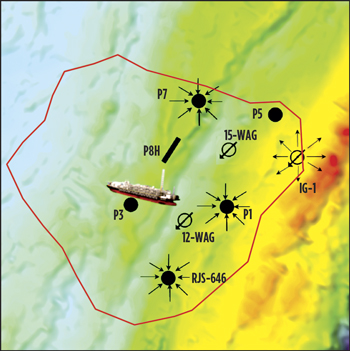 |
| Fig. 4. Lula Pilot’s planned pattern. |
|
To improve reservoir management, intelligent completions are being deployed whenever considered beneficial. Several factors may affect the decision whether to adopt an intelligent completion for each well. Therefore, it is not always recommended to use this configuration. One of the aspects to consider is geological. To be effective, it is desirable to have vertical isolation between zones in the reservoir. Figure 5 illustrates a cross-section through three of the Lula Pilot wells showing different configurations. For instance, the gas injector (IG-1) was completed in two different intervals with pressure gauges. While injection started in the upper interval, pressure was monitored in the lower one. P-1 was also completed in two intervals, mechanically isolated, producing from the interval below. The other producer, RJS-646, was completed in a single zone in the reservoir’s upper region. Being able to monitor bottomhole pressure and the use of chemical tracers in the injected fluid may provide important information to match the production history and calibrate simulation models.
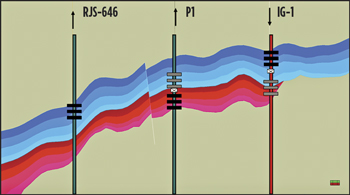 |
| Fig. 5. Cross-section passing through the gas injector and pilot producer wells. |
|
This type of completion can be an effective alternative to mitigating the risk of preferential flow and early breakthrough of injected fluids in the reservoir. The successful use of this feature, together with the flexibility to be able to inject either water or gas (in injection wells), plus the capability to alternate gas injection through different wells, will be a fortunate development in confirming the additional oil recovery expected by EOR in the field.
FIRST FIELD RESULTS
After almost two years of EWT and pilot production, important results were derived from these “Dynamical Appraisal” processes. EWT production data were analyzed in conjunction with fluid and pressure measurements from appraisal and reservoir data acquisition wells drilled in the field. Data obtained cover several topics:
-
Modeling of GOR variation and CO2 concentration along depth and laterally
-
Identification in the drained areas of regions with vertical communication and permeability barriers, and location of relevant geological faults
-
Optimization of well locations, redefinition of perforation intervals, and a selectivity strategy based on reservoir characteristics and behavior
-
Optimization of FPSO locations, due to revised geological and flow models calibrated with dynamic data
-
Absence of flow assurance issues, due to no wax or asphaltenes deposition during production
-
No major problems with inorganic scaling, thus far (although water production is only incipient)
-
Very good performance of CO2 separation process on the FPSO, using membrane technology
-
Water injection test in Lula field, with a good injectivity index and vertical distribution.
At the end of 2011 the Lula Pilot was producing through three wells with one gas injector. Injection started in April 2011, at around 1.0 million m3/d. Gas was mainly HC, with some CO2 content. Figure 6 shows oil production performance since the beginning up to the end of 2012. From September 2011 on, the gas export system was started, and since then, part of the produced gas was separated from the CO2 and exported to shore. The injection well started to inject mainly CO2 (the gas permeated in the membranes, with concentrations higher than 80%) with injection rates around 350,000 m3/d. Since all wells have downhole pressure gauges, pressure is being monitored. Tracer (perfluormethilciclohexane) monitoring on gas injection has also been conducted since June 2011.
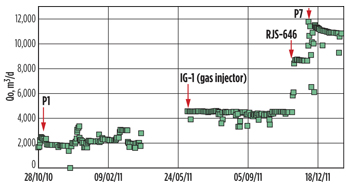 |
| Fig. 6. Production performance of Lula Pilot. |
|
In the pilot stage, important results are being acquired, which can be interpreted both for short-term production plateau maintenance and for mid-term EOR by WAG. Injection rate behavior of the first gas injector is shown in Fig. 7. Average CO2 content in the injected gas is greater than 50% (because CO2 concentrates in the gas that permeates through the membranes). To the best of our knowledge, this is the first time a CO2-rich stream is being injected to improve oil recovery in an ultra-deepwater well completed subsea.
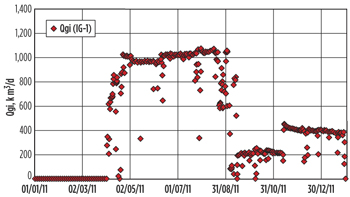 |
| Fig. 7. Gas injection performance, well IG-1. |
|
During this period, gas samples from producers were collected twice a month to investigate the presence of tracers injected with gas. Thus far, none was detected. Another important piece of information is that the producers’ pressure survey showed a change in its tendency after the gas injection rate was reduced. This can be best verified during the period from June to November 2011, when the production rate was kept almost constant and as injection rates decreased. This is an indication that there is good continuity between them.
Additional pieces of information are expected to be gathered soon in the Lula Pilot, with more wells being drilled/completed (Fig. 5). Among them are:
-
WAG injection performance, to start third-quarter 2012
-
Performance and benefits of horizontal drilling. The drilling of the first pre-salt horizontal well was finished in first-quarter 2012
-
Improved understanding of Lula reservoir connectivity, due to additional wells and more pressure tests
-
Increased gas production will allow a more robust evaluation of the gas processing plant and CO2 removal system.
Lula Pilot results are essential for calibrating the simulation studies and selecting the best strategy to maximize oil recovery and project profitability. These outcomes will provide the basis for adopting the optimal strategy for field development in definitive systems, not only for the Tupi area, but also for other Santos basin pre-salt blocks. All this detailed planning and step-by-step achievements are paving the way for a consistent, deepwater EOR application.
CONCLUSIONS
This article has emphasized the importance of early EOR planning for ultra-deep offshore fields. Since all uncertainties cannot be eliminated in fast-track projects, some flexibility must be provided during planning to implement EOR methods.
Lula field reservoir studies indicated that an EOR miscible method (CO2 and/or gas injection alternated with water) can improve ultimate recovery. To make the field-scale EOR application feasible, Petrobras and its partners decided to provide flexibility in the production system, beginning with the project’s conceptual phase.
CO2 injection has several technological challenges, which are being addressed to successfully implement the technique in Lula field. Several unconventional actions are being adopted to support reservoir management strategy. Among them are use of intelligent completions and inter-well tracer injection and production, complemented by daily operational parameter monitoring (pressure, temperature, injection rates, fluids composition, etc.).
Dynamic appraisal proved essential to assess reservoir connectivity, evaluate stimulation methods, support reservoir characterization studies and define aspects related to flow in subsea lines. The phased development strategy helps link information acquisition and cash flow acceleration.
First results of CO2 injection indicate that the chosen strategy has the potential to be successful. Continuing production and pressure monitoring of the WAG implementation, from 2012 on, will provide a more definitive conclusion about its feasibility. Good responses will translate to expansion of EOR to field-scale usage. 
ACKNOWLEDGEMENTS
The authors express their appreciation to Petrobras and its partners in Lula field (BGE&P Brasil Ltda. and Petrogal Brasil), for permission to publish this article. They also acknowledge the fundamental contributions given by Antonio C. C. Pinto. This work also benefited from contributions made by several technical experts who work on the project team. Among them are: Luis Carlos S. Freitas, Tiago R. Homem, Marcelo B. Rosa, Marcelo C. Salomão, Paula I. de Andrade, Bruno Moczydlower, Luciano N. Toledo and Maria Assunção Doria. Their outstanding support is greatly appreciated.
This article is based on a paper presentd by the authors at the SPE EOR Conference at Oil and Gas West Asia, held in Muscat, Oman, April 16–18, 2012. The original paper is copyrighted in 2012 by the Society of Petroleum Engineers
LITERATURE CITED
1. Bondor, P. L. , J. R. Hite, and S. M. Avasthi, “Planning EOR projects in offshore oil fields,” SPE paper 94637, SPE Latin American and Caribbean Petroleum Engineering Conference, Rio de Janeiro, Brazil, June 20-23, 2005.
2. Formigli Filho, J.M., A. C. C. Pinto, and A S. Almeida, “Santos basin’s pré-salt reservoirs development –The way ahead,” OTC paper 19886, Offshore Technology Conference, Houston, Texas, May 4-7,2009.
3. Almeida, A. S., P. S. M. V. Rocha, S. T. C. Lima, A. C. C. Pinto, C .C. M. Branco and M. C. Salomão, “A study on the potential for CCGS in the pre-salt cluster of Santos basin: The Tupi Pilot application,” IBP paper 3503-10, Rio Oil & Gas Expo and Conference, Rio de Janeiro, Brazil, Sept. 13-16, 2010.
4. Nakano, C.M.F., A .C. C. Pinto, J. L. Marcusso and K. Minami, “Pré-salt Santos basin, Extended well test and production pilot in the Tupi area—The planning phase,” OTC paper 19886, Offshore Technology Conference, Houston, Texas, May 4-7, 2009.
5. Moczydlower, B., M. C. Salomão, C. C. M. Branco, R. K. Romeu, T. R. Homem, L. C. S. Freitas, and H. A. T. S. Lima, “Development of the Brazilian pre-salt fields—when to pay for information and when to pay for flexibility,” SPE paper 152860, SPE Latin American and Caribbean Petroleum Engineering Conference, Mexico City, Mexico, April 16-18, 2012.
6. Dake, L.P.: The Practice of Reservoir Engineering, Elsevier, Amsterdam, (1994).
7. U. S. Department of Energy, report number DOE/NETL-2010/1417, prepared by Advanced Resources International, “Storing CO2 and producing domestic crude oil with next generation CO2-EOR technology: An update,” April 30, 2010.
8. Christensen, J.R., E. H. Stenby and A. Skauge, “Review of WAG field experience,” SPE Reservoir Evaluation & Engineering, April 2001.
9. Larsen, J.A. and A. Skauge, “Methodology for numerical simulation with cycledependent relative permeabilities,” SPE Journal, June 1998, p. 163-173.
10. Lake, L. W.: Enhanced Oil Recovery, Prentice Hall, Englewood Cliffs, NJ, 1989.
11. Almeida, A. S., S. T. C. Lima, P. S. M. V. Rocha, A. M. T. Andrade, C. C. M. Branco and A. C. C. Pinto, “CCGS opportunities in the Santos basin pre-salt development,” SPE paper 126566, SPE International Conference on Health, Safety and Environment in Oil and Gas Exploration and Production, Rio de Janeiro, Brazil, April 12-14, 2010.
12. Beltrão, R.L.C., C. L. Sombra, A. C. V. M. Lage, J. R. Fagundes Netto and C. C. D. Henriques, “Challenges and new technologies for the development of the pre-salt cluster, Santos basin, Brazil,” OTC paper 19886, Offshore Technology Conference, Houston, Texas, May 4-7, 2009.
The authors
|
| JORGE PIZARRO is a senior reservoir engineer with Petrobras. He was born in Rio de Janeiro, where he graduated as a civil engineer. During his career, he has worked on the development of several domestic and international projects, mainly designing field development plans and improved oil recovery projects. In 1998, he earned his PhD in petroleum engineering from the University of Texas at Austin. Currently, he works on the Santos basin pre-salt development |
|
| CELSO BRANCO joined Petrobras in 1979 as a petroleum engineer. After a brief period as a completions engineer in the Campos basin, he joined Petrobras Research Center (CENPES), where he served 20 years as a researcher and manager of the laboratories of core analysis, PVT, formation damage and enhanced oil recovery. After 2001, Mr .Branco became involved with reservoir simulation studies for offshore fields in the Campos basin and as coordinator of Petrobras' Offshore Heavy Oil Program (PROPES). Since 2008, he has worked on the Pre-Salt team as a reservoir engineer. He holds an MS degree in petroleum engineering from State University of Campinas (UNICAMP). |
|









